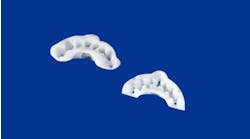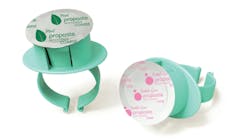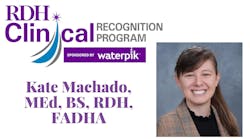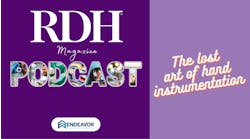by Anne Nugent Guignon, RDH, MPH
Dont you just love it when a word or phrase conveys the truth? The 19th century American poet and philosopher Ralph Waldo Emerson wrote a simple observation: "People only see what they are prepared to see." Emerson's eloquent statement can be applied to many life circumstances. His message is clear.
Obviously this is not a philosophy class, but Emerson's thoughts fit perfectly with the concept of visual acuity, a term that has become increasingly popular in recent years. While one might think the Boomers are the driving force behind improved images, the demand for a crisper, clearer view is a direct result of the dramatic changes produced via electronic imaging. High definition televisions, high-resolution monitors, and even hand-held devices deliver color and clarity at levels never before imagined.
The demands for improved visualization are trickling down to the dental office. In order to enhance visual acuity, products are developing in exciting ways, and we are the lucky recipients of many new technological breakthroughs.
The Principles of Light
In order to appreciate how technology can improve visual acuity, it's helpful to understand some basic lighting and color principles. Light must be present to provide a visual sensation. As the human eye ages the lens becomes progressively cloudy, which decreases the volume of light that reaches the eye. This is the reason people need more illumination as they age.
We've all experienced settings that are too brightly lit, as well as places that are so dim one must strain to see images clearly. Research has demonstrated that overillumination via artificial light contributes to headaches, fatigue, stress, and high blood pressure, and is wasteful and energy intensive.
There are three primary colors — red, yellow and blue. Color is complex. Our eyes perceive millions of different colors based on a combination of different factors, including hue, shade, tint, tone, and chroma. Our response to color is emotional, for example, blue is associated with tranquility and calmness. Did you ever wonder why dental bibs are often blue?
All light has color. Scientists describe the color of light with a scale that measures the color temperature of the light source, which is expressed as degrees of Kelvin. A light source, such as that produced by most incandescent bulbs, is around 4000 K, which is in the reddish orange range. Lighting in this color range does not alter the color of soft tissue such as gingivae. As the degrees of Kelvin approach the 7000 range the light color changes and appears more intense. Light in this color range is known as arctic white light and has a slight bluish tinge. Some feel this is an advantage when matching tooth shades.
Dental office lighting can be a combination of incandescent, fluorescent, and ambient lighting. Traditional incandescent overhead lights provide additional illumination during clinical procedures, and there is increased interest in adding auxiliary lighting in the treatment area. Lights are now available on mirrors, auxiliary headlights, high-speed drills, ultrasonic handpieces, inserts, and even suction devices. These contain additional forms of illumination stemming from a wide variety of technologies: incandescent lights, halogen and metal halide fiber optic lighting systems, and LED technologies.
Miltex's Denlite and Orascoptic's DK lighted mirror feature effective LED illumination combined with a mouth mirror. Each device is cordless. The Orascoptic mirror surface is autoclavable, while the Miltex device uses a disposable, single-use mirror surface.
Besides the light from direct sources, there is the illumination that comes from reflected light. While it may not seem significant, imagine visualizing the oral cavity without reflection from the mouth mirror. Technology has stepped into the mouth mirror arena. Those who use double-sided mirrors attest to the improved visual acuity with two mirrors mounted on one handle. Periodically wiping a mouth mirror with mouthwash will decrease fogging and eliminate water droplets. A number of clinicians report that Oasis moisturizing mouthrinse keeps mirror surfaces clear longer.
Mirror Revolution
There is a revolution in mouth mirror surfaces. While rhodium mirrors have been the gold standard for years, Zirc's Crystal mirrors are made with multiple layers of metal oxide that are visibly brighter, which results in improved visual acuity and truer color rendition. The surfaces of foil-coated moisture control pads also reflect light.
Technology is truly moving us forward. New types of illumination devices are transforming our ability to screen the oral cavity for pathology. While the standard of care still mandates a visual, tactile and digital exam, magnification loupes coupled with auxiliary headlights are redefining the initial intraoral soft exam.
It is becoming routine to incorporate additional diagnostic screening to refine clinical soft tissue observations via exam with either a disposable ViziLite system or the new autoclavable Orascoptic DK illumination source. Patients rinse with an acetic acid solution so soft tissues can be evaluated with a special illuminated light stick. The Velscope emits a special blue light fluorescence, and healthy cells fluoresce, while dysplastic areas appear dark. Areas detected with these screening devices call for additional follow up.
The DIAGNOdent uses laser light technology to determine the relative structural density of a tooth. The machine is calibrated to quantify changes in mineral density, which gives clinicians information about the relative strength of the tooth structure. Based on the findings, clinicians can choose remineralization therapy, a sealant, or restoration to restore structural integrity.
Late last year Dentsply acquired the NEKS caries detection device, the D-Carie mini, which helps identify the presence and location of occlusal and interproximal caries in the oral cavity. It has since been renamed to Midwest Caries I.D.
Digital radiography has provided us with a whole new range of possibilities. We can capture an image, change density, and contrast and enlarge a radiograph, which allows us to evaluate the hard structures of the oral cavity to enhance diagnostic capabilities.
Color technology is playing a growing role in our quest for visual acuity. All dental hygienists are familiar with red dye disclosing solutions that help patients and clinicians visualize plaque biofilm. More advanced products stain new plaque red and old plaque blue. Sunstar Butler's Plak Check kit stains biofilm fluorescent yellow on tooth surfaces without the telltale soft tissue residual dye.
Color technology also includes dental instruments fabricated in colors. Yellow or white probes or colored markings make it easy to record clinical attachment loss or chart pocket depths. 3M ESPE's Clinpro pink colored sealant material is easy and efficient to apply but cures to a natural tooth color. Color enhances precision application, reducing occlusal the adjustments. Color change also indicates that materials such as bonding agents have been mixed properly prior to application.
Removing plaque biofilm with a light polish prior to scaling makes it easier to visualize the tooth surface, and there is less bioburden in the subsequent aerosol created during ultrasonic instrumentation. Young's new Elite prophy cup is unique. The ribs on the outside of the spinning cup capture and hold saliva and prophy paste, which means a better view and less splatter.
Enhancing magnification with better illumination creates a visual event that is hard to quantify. Better illumination will improve visual acuity and create a comfort zone in the treatment room that benefits both you and your patients. If you can't decide what to do, make Nike's slogan your new mantra: "Just Do It."
About the Author
Anne Nugent Guignon, RDH, MPH, is the senior consulting editor for RDH magazine. She is an international speaker who has published numerous articles and authored several textbook chapters. Her popular programs include ergonomics, patient comfort, burnout, and advanced diagnostics and therapeutics. Recipient of the 2004 Mentor of the Year Award, Anne is an ADHA member and has practiced clinical dental hygiene in Houston since 1971. You can reach her at [email protected] or (832) 971-4540, and her Web site is www.anneguignon.com.





